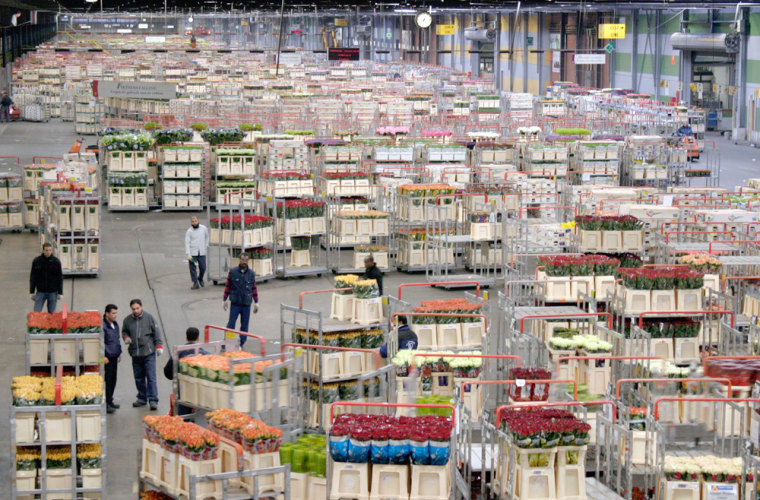At 8:49 a.m. at the Aalsmeer Flower Auction, the tone of Eric Wassenaar's voice is helping set the price for Mother's Day flowers across the globe.
A trolley of blood-red, long-stemmed Grand Prix roses rolls onto the auction floor. These are the queens of the parade -- their bearing regal, their heads erect, their stems long and sturdy, their rating A1, the best there is in the realm of commercial flora.
A rose, in Wassenaar's opinion, evokes more emotion than any flower. It is the favored blossom of poetry and song. But that's what he talks about when he's off the auction floor. At this moment, he's intent on squeezing the highest price he can from the buyers.
Crouched behind a computer in a glass booth, Wassenaar announces the arrival of the Grand Prix in animated staccato bursts. Nearly 500 buyers hunch over narrow desks in tiered rows that climb high above the auction floor. Headsets and computers tie them to the auctioneers. Hundreds more potential buyers track the auction remotely by computer worldwide.
"You have to have eyes and ears on all sides," says Wassenaar, a wiry man with narrow black glasses. "Everything is coming at you at the same time. You can't have a loose connection, you can't lose concentration. You have to be 100 percent every second."
So do the buyers.
They see the crimson splash of the flower-filled trolley moving along miniature tracks set into the concrete floor. Projected above it is a large circular electronic screen known as a clock -- it is packed with everything the buyers need to know about this trolley of Grand Prix: where the roses were grown, the length of their stems, the quality of their heads, the supplier's name, the supplier's reputation, the number of trolleys for sale, the number of containers on the trolleys, the number of stems in each container.
A buyer's brain has less than two seconds to absorb all of those details and tell the index finger to be still or hit the tiny red button that sends a signal to Wassenaar's computer. That tells him which buyer gets the roses -- the exclusive shop in Paris, the florist chain in the Netherlands or the wholesaler in Germany.
Wassenaar has a fraction of a second to confirm, by microphone and headset, the price the bidder will pay -- in this case $1.73 per stem. The first bidder's price is always accepted unless it's considered well below market levels. Then Wassenaar moves to the next sale.
The average time for each transaction is just more than two seconds -- 25 sales per minute, 1,480 sales an hour.
The fastest finger
Here, it's not the highest bidder who gets the consignment, it's the fastest finger, more like a television game show than a traditional auction where bidders drive each other higher and higher.
A numbers cruncher at the auction house, located on the outskirts of Amsterdam, once calculated that the difference between a winning bidder and a loser is about one six-millionth of a second.
So you don't see many older buyers behind the desks anymore, according to Wassenaar, who is 40. The younger generation, with its Nintendo and computer game experience, dominates the hall.
Wassenaar's clock, No. 13, auctions the best and most expensive roses of the auction house. And if there's not enough multi-tasking for one brain, three rose auctions -- each offering different quality roses -- are operating simultaneously in the rose hall. Most buyers also come armed with laptops that allow them to watch the 10 other auctions -- for everything from Green Goddess calla lilies to maidenhair ferns -- that are underway in adjacent Aaslmeer auction halls.
On an average morning, nearly 20 million cut flowers and 2.4 million plants move from the auction house's giant refrigerated warehouses, past its 13 auction clocks, and out to shipping platforms for delivery worldwide.
When the bidders aren't offering prices high enough to suit him, Wassenaar plays to the crowd, injecting more adrenaline into his Dutch tones. The trick is all in the voice. "It's a kind of psychological warfare," he says, adding hastily, "in a good way."
Though the United States was once one of the auction house's top four or five destinations, the depressed value of the dollar has made the flowers too pricey for most American buyers.
Even so, Wassenaar and his fellow auctioneers in the rose hall sell so many roses -- 6 million to 8 million stems in a single morning -- that the prices they fetch influence rose prices in Washington and across the globe. As Mother's Day approaches, he said, rose prices at the auction house will double to meet worldwide demand.
After a 6 a.m. start, the roses assigned to Wassenaar's clock are sold out by 9:45 a.m.
"You're mentally exhausted," says Wassenaar, a 10-year veteran of the auction mike who hands off to a partner after two hours. "But being an auctioneer is one of the greatest jobs there is. Each second, there is something going on."
And when he goes to his local flower stand, what does he buy?
"I don't buy flowers," says Wassenaar, who spends his day surrounded by flowers and often receives gifts of new varieties from growers. "I'm spoiled."
